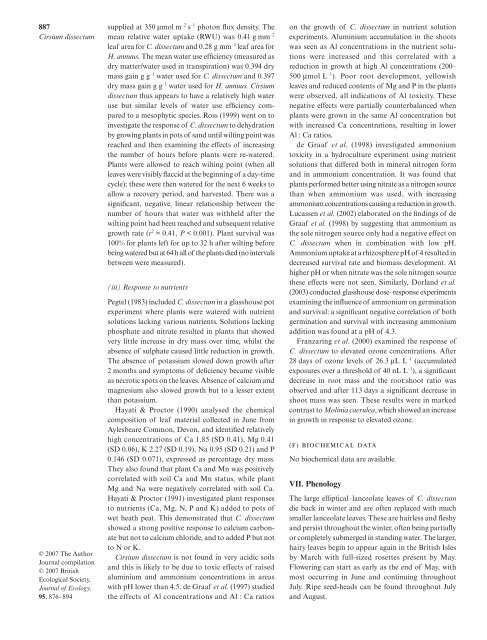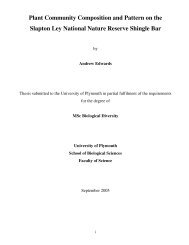de Vere 2007 Biol Flora C. dissectum.pdf - The Whitley Wildlife ...
de Vere 2007 Biol Flora C. dissectum.pdf - The Whitley Wildlife ...
de Vere 2007 Biol Flora C. dissectum.pdf - The Whitley Wildlife ...
- No tags were found...
You also want an ePaper? Increase the reach of your titles
YUMPU automatically turns print PDFs into web optimized ePapers that Google loves.
887Cirsium <strong>dissectum</strong>© <strong>2007</strong> <strong>The</strong> AuthorJournal compilation© <strong>2007</strong> BritishEcological Society,Journal of Ecology,95, 876–894supplied at 350 µmol m –2 s –1 photon flux <strong>de</strong>nsity. <strong>The</strong>mean relative water uptake (RWU) was 0.41 g mm –2leaf area for C. <strong>dissectum</strong> and 0.28 g mm –2 leaf area forH. annuus. <strong>The</strong> mean water use efficiency (measured asdry matter/water used in transpiration) was 0.394 drymass gain g g –1 water used for C. <strong>dissectum</strong> and 0.397dry mass gain g g –1 water used for H. annuus. Cirsium<strong>dissectum</strong> thus appears to have a relatively high wateruse but similar levels of water use efficiency comparedto a mesophytic species. Ross (1999) went on toinvestigate the response of C. <strong>dissectum</strong> to <strong>de</strong>hydrationby growing plants in pots of sand until wilting point wasreached and then examining the effects of increasingthe number of hours before plants were re-watered.Plants were allowed to reach wilting point (when allleaves were visibly flaccid at the beginning of a day-timecycle); these were then watered for the next 6 weeks toallow a recovery period, and harvested. <strong>The</strong>re was asignificant, negative, linear relationship between thenumber of hours that water was withheld after thewilting point had been reached and subsequent relativegrowth rate (r 2 = 0.41, P < 0.001). Plant survival was100% for plants left for up to 32 h after wilting beforebeing watered but at 64 h all of the plants died (no intervalsbetween were measured).(iii) Response to nutrientsPegtel (1983) inclu<strong>de</strong>d C. <strong>dissectum</strong> in a glasshouse potexperiment where plants were watered with nutrientsolutions lacking various nutrients. Solutions lackingphosphate and nitrate resulted in plants that showedvery little increase in dry mass over time, whilst theabsence of sulphate caused little reduction in growth.<strong>The</strong> absence of potassium slowed down growth after2 months and symptoms of <strong>de</strong>ficiency became visibleas necrotic spots on the leaves. Absence of calcium andmagnesium also slowed growth but to a lesser extentthan potassium.Hayati & Proctor (1990) analysed the chemicalcomposition of leaf material collected in June fromAylesbeare Common, Devon, and i<strong>de</strong>ntified relativelyhigh concentrations of Ca 1.85 (SD 0.41), Mg 0.41(SD 0.06), K 2.27 (SD 0.19), Na 0.95 (SD 0.21) and P0.146 (SD 0.071), expressed as percentage dry mass.<strong>The</strong>y also found that plant Ca and Mn was positivelycorrelated with soil Ca and Mn status, while plantMg and Na were negatively correlated with soil Ca.Hayati & Proctor (1991) investigated plant responsesto nutrients (Ca, Mg, N, P and K) ad<strong>de</strong>d to pots ofwet heath peat. This <strong>de</strong>monstrated that C. <strong>dissectum</strong>showed a strong positive response to calcium carbonatebut not to calcium chlori<strong>de</strong>, and to ad<strong>de</strong>d P but notto N or K.Cirsium <strong>dissectum</strong> is not found in very acidic soilsand this is likely to be due to toxic effects of raisedaluminium and ammonium concentrations in areaswith pH lower than 4.5. <strong>de</strong> Graaf et al. (1997) studiedthe effects of Al concentrations and Al : Ca ratioson the growth of C. <strong>dissectum</strong> in nutrient solutionexperiments. Aluminium accumulation in the shootswas seen as Al concentrations in the nutrient solutionswere increased and this correlated with areduction in growth at high Al concentrations (200–500 µmol L –1 ). Poor root <strong>de</strong>velopment, yellowishleaves and reduced contents of Mg and P in the plantswere observed, all indications of Al toxicity. <strong>The</strong>senegative effects were partially counterbalanced whenplants were grown in the same Al concentration butwith increased Ca concentrations, resulting in lowerAl : Ca ratios.<strong>de</strong> Graaf et al. (1998) investigated ammoniumtoxicity in a hydroculture experiment using nutrientsolutions that differed both in mineral nitrogen formand in ammonium concentration. It was found thatplants performed better using nitrate as a nitrogen sourcethan when ammonium was used, with increasingammonium concentrations causing a reduction in growth.Lucassen et al. (2002) elaborated on the findings of <strong>de</strong>Graaf et al. (1998) by suggesting that ammonium asthe sole nitrogen source only had a negative effect onC. <strong>dissectum</strong> when in combination with low pH.Ammonium uptake at a rhizosphere pH of 4 resulted in<strong>de</strong>creased survival rate and biomass <strong>de</strong>velopment. Athigher pH or when nitrate was the sole nitrogen sourcethese effects were not seen. Similarly, Dorland et al.(2003) conducted glasshouse dose–response experimentsexamining the influence of ammonium on germinationand survival: a significant negative correlation of bothgermination and survival with increasing ammoniumaddition was found at a pH of 4.3.Franzaring et al. (2000) examined the response ofC. <strong>dissectum</strong> to elevated ozone concentrations. After28 days of ozone levels of 26.3 µL L –1 (accumulate<strong>de</strong>xposures over a threshold of 40 nL L –1 ), a significant<strong>de</strong>crease in root mass and the root:shoot ratio wasobserved and after 113 days a significant <strong>de</strong>crease inshoot mass was seen. <strong>The</strong>se results were in markedcontrast to Molinia caerulea, which showed an increasein growth in response to elevated ozone.(F) BIOCHEMICAL DATANo biochemical data are available.VII. Phenology<strong>The</strong> large elliptical–lanceolate leaves of C. <strong>dissectum</strong>die back in winter and are often replaced with muchsmaller lanceolate leaves. <strong>The</strong>se are hairless and fleshyand persist throughout the winter, often being partiallyor completely submerged in standing water. <strong>The</strong> larger,hairy leaves begin to appear again in the British Islesby March with full-sized rosettes present by May.Flowering can start as early as the end of May, withmost occurring in June and continuing throughoutJuly. Ripe seed-heads can be found throughout Julyand August.




